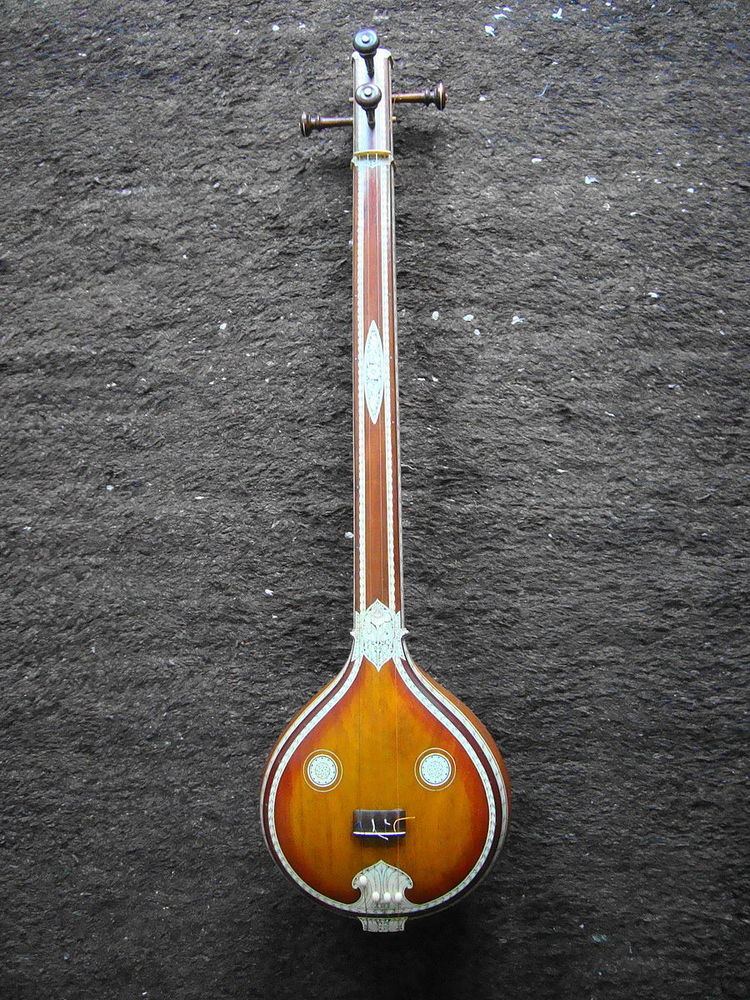 | ||
Graha Bhedam in Carnatic music is the process (or result of the process) of shifting the Tonic note (śruti) to another note in the rāgam and arriving at a different rāgam.
Contents
- Definition
- Practical demo
- Example Illustration
- Melakarta Rgams
- Shankarabharanam
- Kanakangi
- Mayamalavagowla
- Ragavardhini
- Vachaspati
- Shanmukhapriya
- Keeravani
- Ratnangi
- Ganamurti
- Vanaspati
- Manavati
- Sooryakantam
- Kokilapriya
- Gayakapriya
- Dharmavati
- Hatakambari
- Naganandini
- Gangeyabhooshani
- Chalanata
- Shadvidamargini
- Janya rgams
- Mohanam
- Shivaranjani
- Hamsadhwani
- Abhogi
- Amritavarshini
- Gambhiranata
- References
Graha literally means position and Bhedam means change. Since the position of the śruti is changed (pitch of the drone), it is also sometimes called Swara Bhedam or Śruti Bhedam though Śruti Bhedam and Graha Bhedam have some technical differences.
Definition
Modal shift of the Tonic note to higher notes of a rāgam, while retaining the note's positions (swara sthānas – sthāna means position/ pitch), results in different rāgams. This is called Graha Bhedam.
Practical demo
A simple practical demonstration of Graha Bhedam can be taken up by playing the structure of a rāgam with the drone set to Sa (Shadjamam). Then if we keep playing the same keys/ notes, while shifting the drone to another note in the rāgam, to form the new śruti/ tonic note, the result is a different rāgam.
Example Illustration
When Graha bhedam is applied on Shankarabharanam's notes, it yields 5 other major Melakarta rāgams, namely, Kalyani, Hanumatodi, Natabhairavi, Kharaharapriya and Harikambhoji.
Notes on above table
Melakarta Rāgams
Graha Bhedam can be applied on most Melakarta rāgams to yield other Melakarta rāgams (16 of the 72 do not yield any valid Melakarta scale). When applying such modal shift of tonic note, some results are not valid Melakarta rāgams (rules of the definition of Melakarta are violated). Example scenarios are missing Panchamam (Pa) or two of particular note (Rishabham (Ri), Gandharam (Ga), Madhyamam (Ma), Dhaivatam (Da) or Nishadam (Ni)).
Shankarabharanam
See Example Illustration in previous section.
Kanakangi
The Graha Bhedam derivative of Kanakangi is Kamavardhini and vice versa.
Mayamalavagowla
The Graha Bhedam derivatives of Mayamalavagowla are Rasikapriya and Simhendramadhyamam.
Ragavardhini
The Graha Bhedam derivative of Ragavardhini is Varunapriya and vice versa.
Vachaspati
The Graha Bhedam derivatives of Vachaspati are Charukesi, Gourimanohari and Natakapriya.
Shanmukhapriya
The Graha Bhedam derivatives of Shanmukhapriya are Shoolini, Dhenuka and Chitrambari.
Keeravani
The Graha Bhedam derivatives of Keeravani are Hemavati, Vakulabharanam and Kosalam.
Ratnangi
The Graha Bhedam derivatives of Ratnangi are Gamanashrama and Jhankaradhwani.
Ganamurti
The Graha Bhedam derivatives of Ganamurti are Vishwambari and Shamalangi.
Vanaspati
The Graha Bhedam derivative of Vanaspati is Mararanjani and vice versa.
Manavati
The Graha Bhedam derivative of Manavati is Kantamani and vice versa.
Sooryakantam
The Graha Bhedam derivatives of Sooryakantam are Senavati and Latangi.
Kokilapriya
The Graha Bhedam derivative of Kokilapriya is Rishabhapriya and vice versa.
Gayakapriya
The Graha Bhedam derivative of Gayakapriya is Dhatuvardani and vice versa.
Dharmavati
The Graha Bhedam derivatives of Dharmavati are Chakravakam and Sarasangi.
Hatakambari
The Graha Bhedam derivative of Hatakambari is Gavambhodi and vice versa.
Naganandini
The graha bhedam derivatives of Naganandini are Bhavapriya and Vagadheeshwari.
Gangeyabhooshani
The graha bhedam derivative of Gangeyabhooshani is Neetimati and vice versa.
Chalanata
The graha bhedam derivative of Chalanata is Shubhapantuvarali and vice versa.
Shadvidamargini
The graha bhedam derivative of Shadvidamargini is Nasikabhooshani and vice versa.
Janya rāgams
Graha bhedam can be applied to some of the janya rāgams to yield other janya rāgams. Unlike Melakarta rāgams, where strict rules are adhered to, in terms of which swaras can be chosen in a rāgam, janya rāgams do not have such rules. Hence, such modal shift of tonic note is valid on all swaras, but may not have been chosen as a rāgam, experimented, elaborated and composed. Hence they lead to theoretical rāgams, which have not yet been discovered (all combinations of notes exist, but no one has composed using a particular combination or experimented/ exposed to the world at large).
Mohanam
Mohanam rāgam and its graha bhedam derivatives are one of the key scales in use all over the world, especially East and South Asia. The other four derivatives are Hindolam, Shuddha Saveri, Udayaravichandrika (also known as Shuddha Dhanyasi) and Madhyamavathi.
Notes on above table
Shivaranjani
Shivaranjani rāgam and its Graha Bhedam derivatives are Revati and Sunadavinodini.
Notes on above table
Hamsadhwani
Hamsadhwani rāgam and its graha bhedam derivative is Nagasvaravali.
Abhogi
Abhogi rāgam and its graha bhedam derivative is Valaji.
Amritavarshini
Amritavarshini rāgam and its graha bhedam derivative is Karnataka Shuddha Saveri.
Gambhiranata
Gambhiranata rāgam and its graha bhedam derivative is Bhupalam.
